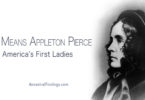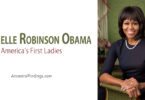Mary Arthur McElroy was the First Lady to 21st US president Chester A. Arthur. She was not his wife. Arthur’s wife died the year before he took office. Instead, Mary was Chester’s sister and performed the duties of First Lady for him while he was in the White House.
Born July 5, 1841, Mary Arthur was a native of Greenwich, New York, and the youngest of nine children born to her parents. Her parents were William Arthur and Malvina Stone. William was from County Antrim, Ireland, and did not come to North America until after he graduated from college in Belfast. He went to Quebec, Canada, and met Malvina there. Malvina was from Vermont, which was just on the border with the town of Dunham in Quebec, where William was a teacher.
Because her father was a teacher, education and academics were important to him, and Mary received an excellent education at the Emma Willard School Seminary in Troy, New York.
On June 13, 1861, Mary married John Edward McElroy, an insurance salesman who was the head of the Albany Insurance company. Together, they lived in Albany, New York and raised four children. All of her children lived past childhood, and three outlived her. Two got married and had their own families.
Her brother, Chester, was elected Vice-President of the United States along with President James Garfield in 1880 and took office in 1881. Later in 1881, Garfield was shot and died of the wound a few months later. As Vice-President, Chester was next in line to the presidency and was sworn in as the new U.S. president. His wife had died almost two years previously, and he needed a First Lady, so he asked Mary to fill the role, but in an unofficial capacity. Chester loved his wife, and was still mourning her when he became president, so he could not bear to give Mary the official title of First Lady that he believed should have been his wife’s; instead, Mary was referred to as the White House hostess, but in fact performed all of the traditional duties of First Lady.
Mary agreed to come to the White House, but she had conditions to her agreement. Mary was living in Albany at the time and was still raising children when Chester became president. She was therefore not able to move to Washington, D.C. full-time. However, she agreed to come stay in the capital city during the busy winter social seasons. Not only did she host official White House events and parties when she was in town, she also helped Chester care for his young daughter, Ellen.
Mary was good at hosting and was a popular First Lady. She honored several previous First Ladies by asking them to help her greet guests at the White House. Because she felt like she had little experience that would qualify her to be a First Lady, she also asked the advice of former First Ladies. Their advice helped Mary tremendously in becoming more comfortable and competent in the role, and her asking the former First Ladies to come help her greet guests at the White House endeared her to the public.
Her eldest daughter and Chester’s daughter sometimes assisted her, as well. The final reception she hosted, which was attended by more than 3,000 people, was held just a week before Chester left office.
Mary and her husband were prominent supporters of civil rights for the newly emancipated African-Americans and even hosted Booker T. Washington at their Albany home in 1900. However, Mary was not as supportive of equal rights for women. She was a member of the Albany Association Opposed to Women’s Suffrage.
Later in her life, when asked about her experience as First Lady, Mary said,
“When I went to the White House, I was absolutely unfamiliar with the customs and formalities.”
That was all she had to say. However, she did learn about those things while she was there, and she taught them to Chester, who coordinated events and hosted them himself when she was not there.
Mary even had an influence on policy during her time at the White House. When former First Lady Lucy Hayes banned alcohol at White House events, much of Washington, D.C. was sorely disappointed. This policy was overturned by the next presidential couple, James and Lucretia Garfield. Because Garfield was president for such a short time, temperance advocates thought they could easily get the alcohol ban reinstated at the White House, and put a lot of pressure on Mary McElroy to order the White House to go dry once more. She refused, and alcohol remained part of the White House social scene until Prohibition.
Mary was also a staunch supporter of her brother, whose policies as president were not always popular. Without his wife by his side, it was nice and comforting for him to have a devoted sister who always stood up for him and told him he was doing the right thing, no matter what. Family loyalty mattered to Mary, and she always stood up for whatever Chester did.
Mary went home to Albany after Chester left the White House and retired from politics. She finished raising her children and became active in the social life of Albany with her husband. They dabbled in political causes but never entertained political ambitions themselves. The world of the White House showed Mary that life was not for her or her family.
Mary lived the rest of her life in Albany, enjoying her remaining children and grandchildren, and was a devoted mother, grandmother, and wife. She died January 8, 1917, and was buried in the Arthur family plot at the Albany Rural Cemetery in Menands, New York, just outside of Albany proper. Chester is buried there, too, with a large, marvelous presidential monument. Mary, along with many other members of the Arthur family, is buried nearby, with much smaller monuments to them. Her legacy as de facto First Lady is right there, next to her brother, the President.






